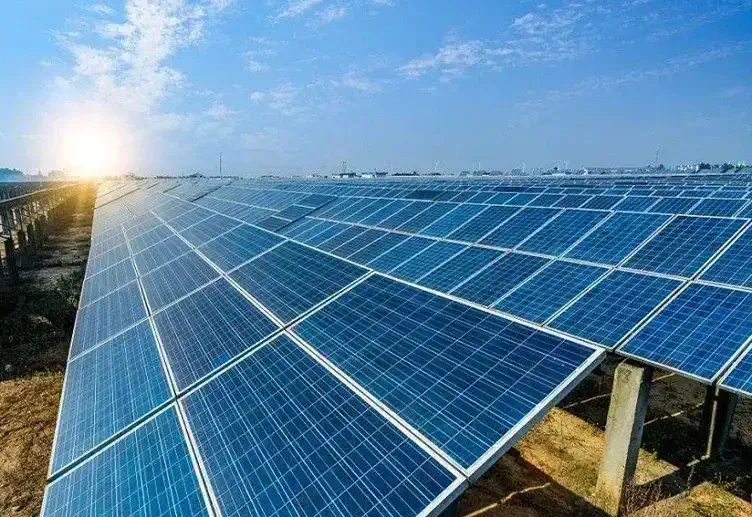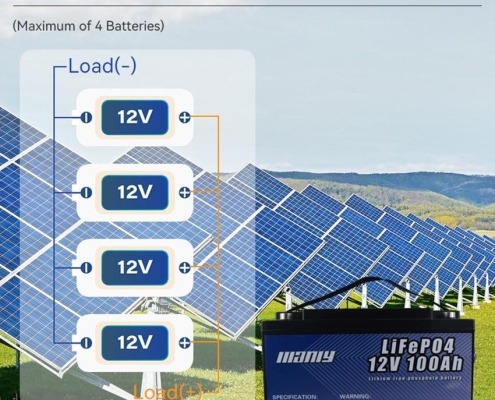Top Solar Battery Types & Their Benefits
Table of Contents
People love solar energy because it’s endless, always available, and doesn’t pollute. More folks are choosing to use solar energy because it’s a clean energy choice. This choice is becoming even more popular as we become more concerned about the environment.
Types of Solar Batteries (Photovoltaic Panels):
1. Monocrystalline Silicon Solar Battery:
Monocrystalline silicon solar batteries have a structure that includes front comb-shaped electrodes, anti-reflective film, N-type layer, PN junction, P-type layer, and back electrode. These solar batteries are made from high-purity monocrystalline silicon rods. These rods are sliced and processed through several semiconductor techniques to form the PN junction. Then, the grid lines are made using screen printing and the back electrode is produced through sintering. These individual slices can be assembled into solar battery modules or photovoltaic panels with the required voltage and current. Then, they are framed into different sizes of solar arrays. Currently, the efficiency of these batteries is around 18%, but it can reach up to 24%.

2. Polycrystalline Silicon Solar Battery:
Polycrystalline silicon thin-film solar batteries use a relatively thin layer of crystalline silicon as the active layer for the battery. This not only keeps the high performance and stability of crystalline silicon solar batteries but also significantly reduces the cost. The working principle is similar to other solar batteries, based on the photovoltaic effect when sunlight interacts with semiconductor material. These batteries use polycrystalline silicon that contains a lot of single-crystal grains or is melted from waste monocrystalline silicon material and metallurgical silicon. This silicon is then poured into graphite molds to form polycrystalline silicon blocks. These blocks are cut into square slices for battery making. Their production process is similar to monocrystalline silicon solar batteries, but they are more efficient, up to about 16%. They are also cheaper to produce, which is why they are popular.
3. Amorphous Silicon Solar Battery:
Amorphous silicon solar batteries consist of a transparent oxide film (TCO) layer, amorphous silicon thin film P-I-N layer (I layer is the intrinsic absorption layer), and a back electrode metal thin film layer. The base can be made from aluminum alloy, stainless steel, or special plastics. Their production method is very different from monocrystalline and polycrystalline solar batteries. They use less silicon and even less electricity. The most common method is using glow discharge to get either N-type or P-type amorphous silicon film. These batteries are thin and can be made in layers or using integrated circuit methods to produce many series-connected batteries for higher voltage. However, their efficiency is lower, around 10% at the international advanced level.
4. Compound Solar Batteries
Cadmium sulfide and cadmium telluride thin-film solar batteries boast higher efficiencies than amorphous silicon batteries, but they’re cheaper than monocrystalline silicon batteries. On the global stage, many nations are shifting from lab research of cadmium telluride thin-film solar batteries to mass industrial production.
- a. Cadmium Sulfide Solar Batteries: Even with their photoelectric efficiency now reaching 9%, they still can’t compete with polycrystalline silicon solar batteries. However, their production process is simpler than that of amorphous silicon thin-film batteries.
- b. Gallium Arsenide Solar Batteries: These have a good match with the solar spectrum and can withstand high temperatures. Even at 250°C, their photoelectric conversion remains robust, with peak efficiencies around 30%. They’re particularly suitable for high-temperature concentrator solar batteries. But due to the scarcity of gallium and the toxicity of arsenic, their high manufacturing costs limit their development.
- c. Copper Indium Selenide Solar Batteries: These batteries, made of a trinary compound semiconductor, have a polycrystalline thin-film structure. They’re cost-effective, stable, and boast photoelectric conversion efficiencies over 10%. They’re emerging as strong competitors to amorphous silicon thin-film solar batteries.
5. Nanocrystal Chemical Solar Batteries
Dye-sensitized nanocrystalline solar batteries (DSSCs) mainly consist of a transparent conductive film-coated glass substrate, dye-sensitized semiconductor material, counter electrode, and electrolyte. Its anode is a dye-sensitized semiconductor thin film (TiO2 film), and its cathode is platinum-coated conductive glass. These solar batteries are favored for their low cost, straightforward manufacturing process, and stable performance, with efficiencies consistently over 10%. Their cost is just a fraction (between 1/5 and 1/10) of silicon solar batteries, and they have a lifespan of over 20 years.
6. Tandem Solar Batteries
Layering batteries enhances their performance. Thinner photovoltaic panels mean devices can feasibly be stacked. These layers can either be of the same device or different types. Each layer, due to its unique photo-response properties, absorbs different solar light wavelengths. This layering ensures better absorption across the full spectrum of sunlight, and due to the coupling effect between devices, overall photo-energy conversion rates can be even higher.
7. Flexible Solar Batteries
Flexible solar battery panels are made of high-quality silicon material, laminated with solar-specific tempered glass known for its strength and transparency, and a high-performance UV-resistant sealing material. They’re resilient against snow, shocks, and pressure, maintaining functionality even under harsh temperature fluctuations. This flexibility means they can be employed in areas where flat-panel solar batteries might struggle, such as solar-powered cars, airplanes, airships, buildings, textiles, tents, clothing, helmets, toys, and other uniquely curved surfaces.
Benefits of Solar Batteries
- Solar energy is inexhaustible; it’s a resource we won’t run out of.
- It’s environmentally friendly. Photovoltaic power generation doesn’t need fuel and emits no CO2, ensuring cleaner air. Plus, there’s no noise.
- Versatility is key. As long as there’s sunlight, solar battery systems can work anywhere, unrestricted by location or altitude.
- With no moving parts, operation and maintenance are straightforward. They’re reliable. If the sun’s out, the photovoltaic panel produces power. And with today’s automated systems, manual operations are minimal.
- Abundance in raw materials. Silicon, used in solar batteries, is plentiful. It’s the second most abundant element in the Earth’s crust, after oxygen, making up about 26%.
- They last a long time. Crystalline silicon solar batteries have a lifespan ranging from 20 to 35 years. With proper design and battery selection, storage batteries within the system can also last up to 10 years.
- Solar battery units are simple in design, compact, and lightweight, which makes transportation and installation easy. The construction timeframe is short.
- System integration is a breeze. Several solar battery units and storage batteries can be combined to form solar arrays and battery groups. Inverters and controllers can also be integrated. Systems can be scaled up or down, making expansion effortless.
- Energy payback is quick, roughly 0.8-3.0 years. There’s a clear energy value-add, about 8-30 times over.
Conclusion:
The transformation of the energy sector is evident with the growing popularity of solar energy. Solar batteries, especially photovoltaic panels, are the forefront of this revolution. These batteries, ranging from Monocrystalline to Flexible varieties, showcase the innovation and versatility the industry offers. They are eco-friendly, abundant in raw material, and highly reliable. As we aim to tackle environmental concerns and prioritize clean energy, the prominence of solar battery technologies is evident. They are not only cost-effective but also efficient in harnessing the sun’s inexhaustible energy, making them an ideal solution for today’s and tomorrow’s energy demands. The future is bright with solar energy leading the way.





